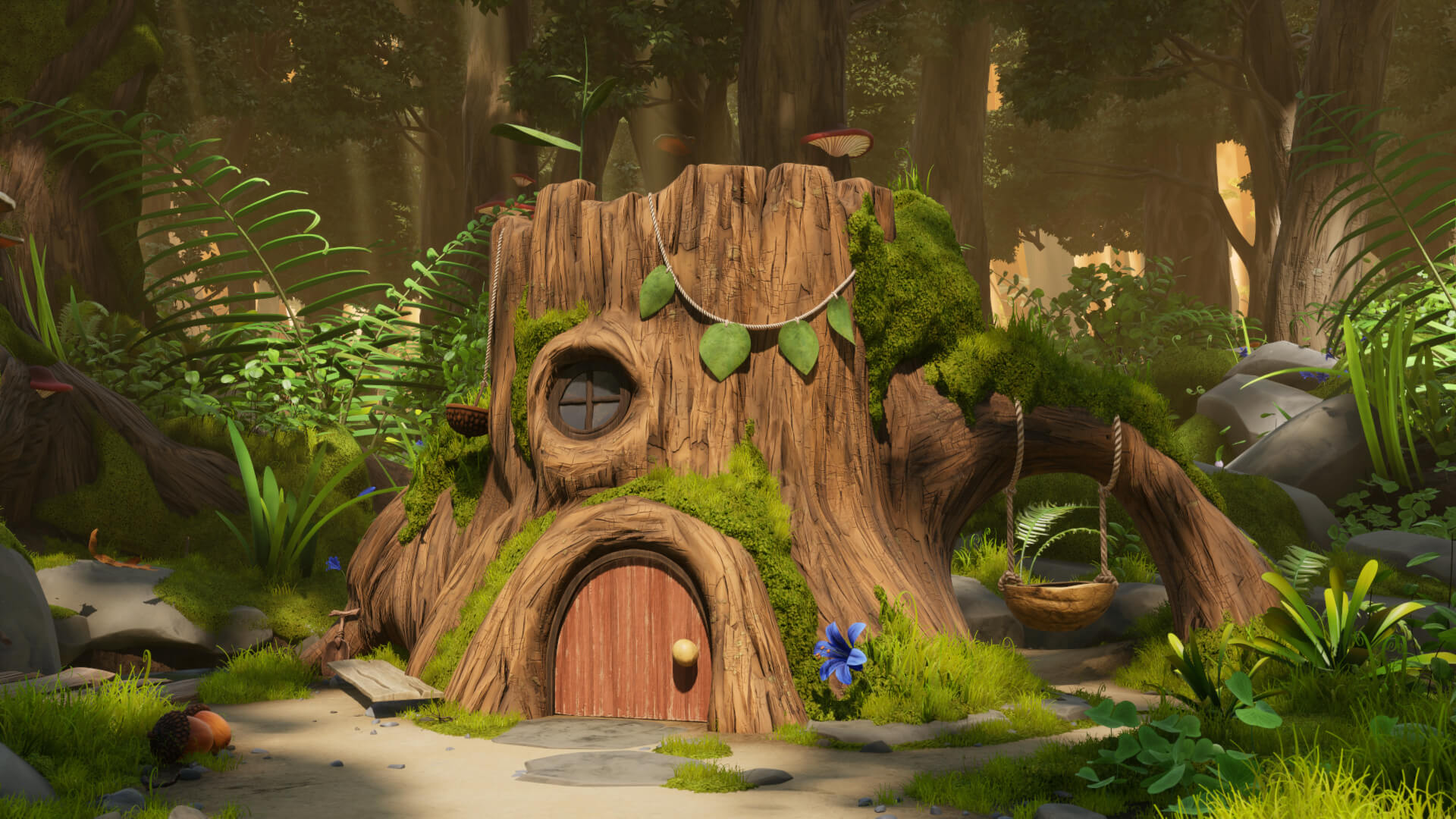The path to sustainable animation with Mush-Mush & the Mushables
Animation isn’t typically what people think of when considering environmental impact, but like all things, it leaves a mark. Heavy rendering time, air conditioning, and more go into making a feature or episodic production, which can use a lot of electricity. So what is an eco-conscious studio to do—especially when they want to innovate and entertain just as much as anyone else?
La Cabane went real-time, updating the production process of their international Emmy®-nominated animated series Mush-Mush & the Mushables with a pipeline that not only delivered the goods, but dropped their carbon footprint.
The adventure begins
Even before these innovations, France-based studio La Cabane was heading in a great direction. Mush-Mush’s first season had become a worldwide hit, hooking kids into a charming world populated by pint-sized forest guardians. Its tales of self-discovery and deep connection to nature resonate, not only with its audience, but with La Cabane’s management, who see creative responsibility as an important part of their DNA.
“The quality and the values of the content you put in front of children really matters,” says Perrine Gauthier, Producer and Founder at La Cabane. “Mush-Mush is built around the idea of exploration, not only of our own unique talents, but our communities and surroundings, as well. It invites children to be curious about themselves and the world around them, treating life like a big, fun adventure for us all.”

Mush-Mush & the Mushables © 2022 – La Cabane Productions – Thuristar – Cake Entertainment – VRT-Ketnet – RTBF Télévision belge
La Cabane clearly has its positive messages (and intent) down, but like all conscientious companies, they wanted something more. They wanted their values to not only live on the page, but in the pipeline bringing their ideas to life. The only issue was that for years, the tech they needed to do this wasn’t there.
Rumblings of game engines and the possibilities of real-time technology intrigued them, though. So much so that they started toying with the idea of making a switch, and conducted experiments to see if one of the engines could bring real-time benefits to Season 2.

Mush-Mush & the Mushables © 2022 – La Cabane Productions – Thuristar – Cake Entertainment – VRT-Ketnet – RTBF Télévision belge
Together with their new CG studio partners Shards CGI, who have recently specialized in Unreal Engine, La Cabane made their way to a more efficient and eco-friendly pipeline. Since then, they’ve seen a 90% reduction in rendering time, and just as drastic cuts to the project’s electric consumption, render farm, and air conditioning needs.
The big test
During the production of Season 2, the first major opportunity to test the pipeline came from Cartoon Forum, which asked La Cabane to produce a teaser for their 2021 event.
As the ask was for Europe’s biggest animation pitching and co-production event, it was a great honor for the whole team. The teaser, made by La Cabane and Shards CGI, exposed online and onsite audiences to an amusing conversation between Mushables weighing options on a breaking branch.
The pipeline was not only working—it was delivering results that made working easier. “It’s amazing when you can iterate quickly, and not have to wait for hours to see the result of your render,” says Romain Trimaille, CEO and Head of CG at Shards CGI. “That alone gives us a lot of flexibility in the workflow and also creates more comfortable work conditions for our team. It’s harder to get frustrated when everything is so immediate; plus, having so much info and detail in front of you really guards against re-dos further down the line.”
Shards CGI is already waiting to see if real-time capabilities come to rival more traditional animation methods, particularly for things like glass, vegetation, and hair.

Mush-Mush & the Mushables © 2022 – La Cabane Productions – Thuristar – Cake Entertainment – VRT-Ketnet – RTBF Télévision belge
Crafting season two
So what does Unreal Engine add to Mush-Mush?
The team uses it as part of a Blender workflow that sees the layout, lighting, and final-frame rendering of the project performed in Unreal Engine. By using Unreal Engine for the layout, La Cabane and Shards CGI have been able to anticipate any issues with lighting and rendering during pre-production, improving efficiency, and avoiding the need for significant re-rendering of frames when artistic or technical issues arise later in the process.
This also means the Director, Joeri Christiaen, is able to choose camera angles that already account for the light’s direction and shadows, achieving the best photography for a scene while also dodging potential light and shadow-related issues later on.

Mush-Mush & the Mushables © 2022 – La Cabane Productions – Thuristar – Cake Entertainment – VRT-Ketnet – RTBF Télévision belge
“Unreal’s internal reference system is powerful and gives us a lot of flexibility, enabling us to rapidly iterate between different versions of our shading, lighting, and rendering,” says Trimaille. “And the drastically reduced render times are another big advantage. On Season 1, final images were coming in at 50 minutes a frame; we are hardly at three minutes for Season 2, which means we can spend a lot more time on creative quality and introduce more subsurface scattering for added detail.”
The more they worked, the more the team realized they could apply these quality improvements to previously rendered elements, including the series’ opening sequence.
“We saw a chance to push the quality even further, while still preserving the look of the show,” says Gauthier. “Now, the render is crisper, the colors are even more vibrant, and the forest is more alive than ever thanks to Unreal’s environment abilities.”
Full steam ahead
Production is still ongoing for Season 2, with compositing slated for this summer, and the first episodes being finalized by the end of the year.
“The episodes are coming together nicely, we are doing what we care about the most: creating stories built on subtle emotions and stakes that will translate to more than just children. We often get messages from parents saying, ‘Thank you for making a beautiful kids program that doesn’t make me want to throw the TV out the window.’ I quite like this compliment!” jokes Gauthier.
And although the transition to real-time hasn’t been without its hurdles, Gauthier believes it’s worth it, noting that innovations rarely come without additional risk and cost, but choices like this one will hopefully contribute to reducing the carbon footprint of the animation sector. La Cabane is also working with a sustainability consultant to evaluate their emissions after the switch to see exactly how it will help them reach the objectives of their decarbonization plan.
“New pipelines bring fresh perspectives on your projects and workflows,” says Gauthier, “and interesting things happen when one gets out of their comfort zone.”
Hear, hear! Mush-Mush is living proof.

The second season of Mush-Mush & the Mushables will premiere internationally in 2023. To learn more about La Cabane and their productions, head to their official website.
Source:UBSOFT

熱門頭條新聞
- Alibaba Sells Gao Xin Retail for HK$13.1 Billion
- “Paddington in Peru “, a Live-Action Animated Adventure Comedy Film
- Grand Prizes for “Beautiful Man” and “Memoir of a Snail” at Cinanima 2024
- FragPunk’s March 6th 2025 Release Date Revealed at The Game Awards
- Asfalia: Fear Debuts In January
- Nordic Game 2025: Good Things Ahead
- Battery Note+UNDERGROUNDED will release in 2025!
- Sugardew Island – Your Cozy Farm Shop Launches for PC and Consoles in March 2025!
